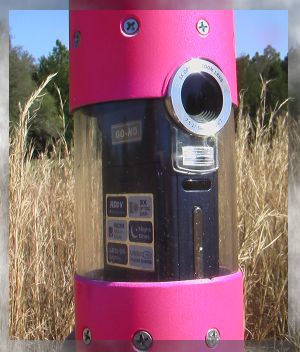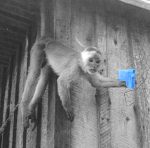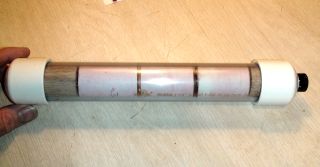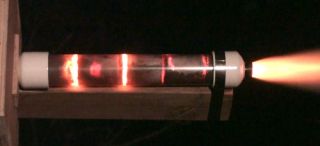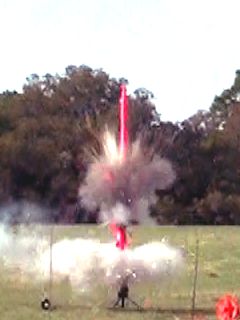Recrystallized Rocketry
Serious about safety, silly about the rest
Specializing in Rcandy: KNO3/Sucrose propellant
made by solution and recrystallization.
New to rocketry? Returning to rocketry?
Check out the Fly Rockets website!
What this site is about: Nourshing the spirit through learning, thinking, and discovery. Flights of fact and of fancy.
Extraordinary achievements using ordinary things. Making ROCKETS!
What this site is NOT about: Bombs, weapons, crime, hate, and fear.
If you have intent to harm persons or property, to flout the law,
or
even to frighten others, you may NOT use my methods! Essential to
the
method is an attitude of care and profound respect for others, their
persons,
their property, and their peace of mind. Rocketry is inherently
dangerous. To do it, we must adopt the highest of ethical
standards and practice them faithfully.
It's a dog-eat-dog
world.... so don't be a dog!
This site is NOT about fireworks either, although I love them too.
The
laws and rules for fireworks are different than those for rocketry.
To
avoid excess confusion I will present here only those techniques that are relevant
to rocketry.
This may not be readily apparent, as some of the same
techniques are used in both venues.
Monoblogue
- Can't get enough of my verbiage? There are therapies, you
know... But until you find the right medication, here is more.
Answers to questions I have received in e-mails over the last
couple of years. I could go on and on... and I do!
Leaders in Sugar Rocketry -
a collection of links to sites of other researchers working with this
propellant.
Please read their SAFETY pages as well as mine!
I recommend reading each and every one of these sites before
commencing any rocketry experiments.
This is one area where ignorance is NOT bliss. It can be a blast, and not necessarily the fun kind.
. If it makes you go "WOW!" it can also make you go "OW!"
Here is some of my newer stuff:
Old News, Old Notebook
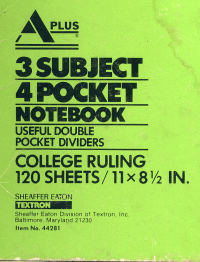 | I found and scanned one of my notebooks from the previous century.
Starting in March 1980
Pretty boring, mostly, but there for posterity.
It includes one of my earliest formal descriptions of the rcandy procedure.
Next in the series, August 1980 until February 1981.
This one is a lot longer... I finally got some C and D-class motors to work occasionally.
By
the end of the book the motors were working fairly reliably, and I had
my first shipment of pyrotechnic chemicals to play with.
Colored stars! I was in pyro heaven.
|
Static Testing Made Easier
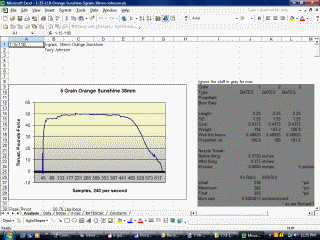
| Videos illustrating the conversion of test stand data to an Excel spreadsheet which analyzes motor performance. |
Launches you may not have seen
Dire Warning! .... Is now abated...somewhat.
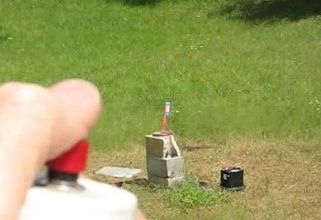 |
Two
students from University of South Florida were arrested in August 2007
for transporting sugar propellant rocket motors across state lines.
One of them went to prison... for something else.
The other was acquitted - found "not guilty" because he did not make the rocket motors, nor did he have any knowledge of them.
Fortunately for him. Unfortunately for us as the court decision thus had no influence on the legality of sugar propellant.
So the risk remains.
Activities shown on these pages may not be legal in your area.
Please check out the Federal, state, and local laws before engaging in rocketry activities!
So now that the case has been resolved, I feel safe in releasing my "court documents."
They are videos and other documentation used to demonstrate that these PVC sugar motors are not "pipe bombs." |
November 2006:
Amateur Icelandic Rocketry
launches sugar rocket.
Click here for media coverage
Click here to visit the AIR website |
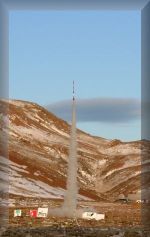 |
I
am very proud of my rocketry friends Steinn, Smeyr, and Magnus, who
successfully launched their KNO3/sucrose rocket in November 2006.
As far as we know, this is the first amateur rocket launched in
Iceland. |
Making Propellant
- Safety First -
if you are going to make this propellant, you MUST read this page and heed its instructions to stay well, stay whole,
and stay out of trouble. Even that may not save you, but it's a start.
- Electric Skillet Rcandy - A simple change in technique allows this method to make large amounts
of propellant in a short time. I'm
using this method exclusively nowdays. Also check out the Propellant episode of my Model Rocket Movies. (4/06)
- No Karo? No Problem!
Alternatives to corn syrup. A little dextrose and fructose
works well. Glucose syrup is reported to be OK.
- Recrystallized KN/Sucrose - Oven method. No longer recommended. It's good, but the skillet is better. (5/01 rev. 6/03) Russian
translation (3/05)
- Static-Load Compression tests
- this propellant proves to be very strong under static load (8/01)
- Drop Tests - Dynamic test of propellant
strength - ball of propellant breaks when dropped onto concrete. Duh. (8/01)
- Tensile strength Tests - 1/4 inch
diameter strand of rcandy supports over 10 pounds (8/01)
- Lacquer: Attempts to deal
with the hygroscopic nature of KN/Sucrose by coating with flammable paint
(10/01)
- Iron Oxide used as a catalyst - increases
burn rate, facilitates ignition, pretty color. (4/02)
- Sugar Syrup - alternate method of
making KN/SU propellant. Quicker, easier, seems fairly safe, but propellant
is not as good (10/03)
- Titanium - Adding small amounts
of Ti flake gives this propellant a crackling, sparky tail. (3/04)
- Toaster Oven Rcandy - Development
of methods to produce small amounts in a small oven. Possible, but not elegant, not recommended. (3/05)
- NaNO3 - sugar syrup propellant
made with sodium nitrate. Funny texture makes it a little harder to
work, but fires OK in motor. (1/04)
- "Candy Rocket" Making rcandy with Pixy Stix, Jolly Ranchers, Starlite mints, etc. This is the one Theodore Gray refers to in his Popular Science article, June 2006 issue. (5/06)
Making Motors
Reloading the Aerotech-type 38mm casing (also works for Dr. Rocket and RouseTech Monster motors, since they are Aerotech-compatible)
- First Tests - initial developments
(11/02)
- Static Tests - 29 static
tests plus one flight test of these motors (12/02)
- Making the Grains - forming techniques,
plus ignitors and motor assembly (12/02)
- Analog Test Stand - made from
trash. Works better than it looks. (11/02)
- RATS launch - demonstration flights for
the TRA Sugar Proposal authored by Stuart
Leslie, with marginal assistance from me. (10/02)
- Delay Grains - enable motor ejection,
allows launching of non-electronic airframes, provide tracking smoke too. (12/04)
- Tidy Packages
- Full demonstration of the making of propellant loads for a 38-360
motor casing. Propellant grains encased in an airtight package,
which also serves as case liner. These loads keep very well, and
are easy to load in the field.. (3/05) Here is the same procedure for sealign up 54mm loads
- NEFAR launch 2/12/05 - flight
testing delay grains and tidy packages. They work! (repeat link from above) (3/05)
Testing the motors
Digital Electronic
Test Stands (1/05)
- Stand A, built
by Steve Ghioto, 20kg load cell from Aerocon Systems
- Stand B, built by Steve Ghioto, 500lbf load cell from Aerocon Systems (photo, 110k)
- Bathroom scale test
stand - full 300lbf system for about $60. (1/05)
- Building the INA125 amplifier
needed to get the load cell talking to the Dataq unit. (11/04)
- Static tests through 8/05 performed with
these devices: thrust curves, videos, spreadsheet analysis. This file was getting too big, so I'm dividing them up:
- Static tests performed 9/05 through 12/05. I have started dividing up the tests by month, but haven't backtracked to the olden days. (10/05)
- Static tests performed in 2006 - Wide variety of static tests. (7/06)
- Static tests performed in 2007
- Videos illustrating the conversion of test stand data to an Excel spreadsheet which analyzes motor performance.
Making airframes
Ejection Devices
- Smokeless powder ejection tests
- promising results: Red Dot may be better than black powder for ejection
charges
- Smokeless ejection II - "static
tests" using Red Dot in a real airframe with parachute. Worked well.
- Timers.
A page based largely on ignorance. This page is intended
to present timer options to a new flyer. I've never made a timer, and
have used them very little. But that
doesn't prevent me from talking about it! It's on the web so folks with more experience can correct my errors. (4/07)
Making them fly!
NEFAR and other organized launches
- December 13, 2003 - NEFAR my first launch of the Sugar Rush, first flights with the 54mm Loki casing,
- May 2004 - NEFAR first flights using Ti-enhanced Rcandy and 3-grain 54mm Loki motor
- August 15, 2004 - Amateur launch
- I got to fire the Sugar Rush twice, both times successfully. Post-hurricane
wet slog recovery. (8/14)
- November 2004 - Still photos
only, but some nice ones! (11/04)
- February 12, 2005- Testing delay
grains and tidy packages in Dr. Rocket motors. Ariel fired twice, small
fire started by errant Ti. (2/05)
- April 9, 2005 - Movies of my first two moon-burner flights, and two launches of Richard Creamer's radio recovery rocket,
flown with motors by Steve Ghioto (4/05)
- May 2005 - two-day launch. I
fired my two rockets four times, and perusaded other club members to fire
four more in their airframes. (5/05)
- August 2005 - Two flights
of the Sugar Rush. First one straight as an arrow with BATES
grains. The second using a moonburner grain, wags its tail upon
liftoff so severely as to cause early ejection at motor burnout.
- October 2005 - Big Sugar Launch. Team project with Rick Creamer and Steve Ghioto. 9 foot rocket went to about 4000 feet (11/05)
Also Ti night launch. Delay grain failure made for a spectacular photo, and a very low flight. - November 2005 -
Big Sugar Launch 2. Due to "operator error" my video camera did
not catch the flight. But others contributed their photos and
movies to make for a pretty good show. Motor and airframe worked
well. Nothing else did.
- February 2006
- The Sugar Rush gets to fly with its new nose cone and blows it. Not
the nose cone, the fin department. Motor casing is overpressurized
and blows out the head end closure. But that was a good thing! Really!
- March 2006 - Rebuilt the lower
section of the Sugar Rush, obtained a new Loki 4-grain 54mm motor, and am
ready to fly again. 3 good flights, paper nose cone works fine.
- April 2006
- Jonathan Carter was here for a few wonderful days. We went to the NEFAR
launch, where he fired his Like a Woman Scorned airframe using his own K-motor
burning KN/dextrose. An impressive flight. I had reconfigured
the Sugar Rush for dual deployment again. Fired
once using the 4-grain 54mm Loki motor and Pixy Stix
propellant. Sims put apogee at 5100 feet, altimeter said 2510 feet.
Quite a discrepancy there. Check out the video and judge for
yourself.
- May 2006 - I fly the Sugar
Rush to one mile altitude using Pixy Stix propellant. But there
is an anomaly in the ejection, drogue does not pop after apogee and rocket
is last seen heading down the way it went up. Will I find a
smoking pink hole in the pasture? Check out the
"long" video, and make sure your sound is on! (5/06)
- July 2006 - Maiden flight of
the Pixy Stix Drifter, a project started by Pete and Dennis, and
donated "to a good home." Don't know about the good home part of
it, but she finally flew! Sugar Rush flies again on 5-grain
motor.
- August 2006 - Video of
Steve and Rick's camera rocket. Sugar Rush
flown on propellant load made by UCF engineering students in our
workshops back in July. Their motor load worked great! My
recovery system did not work so great.... The cows know where it
is, but they are not talking.
- September 2006
- Since my Co-Pilot wouldn't wake up and my new ARTS has not yet
arrived, I am without altimeter and thus unable to launch a large
rocket. Two saucer launches will suffice, as well as an
opportunity to observe some other really nice launches. These
include a beautiful boosted-glider, an unreal close proximity landing,
and a short-range hybrid lawn-dart. (9/06)
- October 2006
- No web page yet, just a link to the 9-meg launch movie. Pixy Stix
rocket launched with 4-grain Loki motor using 3 grains for propellant and
one for smoke. Apparently smoke grain broke in half and burned as propellant,
as acceleration and altitude were greater than simmed, and there was no trailing
smoke.
- January 2007 - See the Sugar
Rush in her underwear! Actually, just the white primer coat. Spent
all my painting time working on a new electronics bay, altimeter plus backup
timer. Drogue deployed, main didn't. Post-mortem sheds interesting
light on Red Dot and my recovery charge packet design...
- Florida Winternationals,
January 2007 - videos of a couple of launches of "interesting" projects by
Ed Wilkes. Also, a demo of the Gorilla Motors sparky propellant in
Mike Kiss' Wildman rocket (mislabeled "Thor" in the video)
- February 2007 - Launches of several
NEFAR folks, including the first two hybrids that I have seen that actually worked.
Video camera mounted in the Sugar Rush, temporarily renamed the "pinkeye." Flight was low and slow, apogee at 820
feet. Good video was obtained from the Aiptek MPVR+ onboard. These videos are on the NEFAR website, www.nefar.net
- March 2007
- Another small gallery of launches on the NEFAR website, including a
drag race between the Sugar Rush on KN/sucrose, and a Wildman on Wimpy
Red. Also first launch using "beer propellant" made with dry malt
extact. 3/24/07
- Rocketry Organization of South Carolina (ROSCO) ICBM launch at
Orangeburg, March 31/April 1, 2007. An outstanding launch with
lots of sugar being flown. Here is my video collection.
- April 2007 NEFAR launch. Fired the Sugar Rush once with handicam. Several other launches documented.
- June 2007 - NEFAR launch. I mostly watched and filmed other folks' launches. (redirect to NEFAR website)
- July 2007 - NEFAR
launch. I blew in from the West just as a huge thunderstorm
system was coming in from the East and everyone was frantically tearing
down, putting away and driving off. Thus I captured no flight video. But some members got there on time and flew in the morning. I've uploaded a few of their videos to the NEFAR website.
- August 2007
- I flew the Sugar Rush once, this time using the propellant load we
made in the Thunderflame course back in July. It worked great!
You know, AP isn't all that bad... There are lots of other
interesting launches on this page as well.
- September 2007
- One more flight of Sugar Rush with Aiptek camera, this time on a Loki
2000 casing, sparky sugar moonburner. Again many more launches.
Sugar Rush is #43 of the 53 I caught on tape.
- October 2007
- Another fine NEFAR launch. I get so excited capturing video of
other folks' launches that I don't do many myself. But I did get
in another flight of the Sugar Rush with camcorder onboard. The
humidity had dropped below the usual 90 percent, resulting in a clear
day and perhaps the best video so far. It is launch #63, way down
on the page.
- Bunnell Blast - November 2007.
I caught video of many launches, including several nice sugar motors by
Scott Jolley, Marc Slabbinck, and Steve Ghioto. Sugar Rush was
launched twice. Camera glitch during first launch resulted in bad
file, thus no onboard video. Second launch obtained good video, but not quite as pretty as the October launch.
- January 2008
I did a silly thing at the NEFAR launch, sending up TWO long
rockets at once. Both are male, both are pink, so this is a real
Drag Race! Both had cameras running, one of them high definition.
- February 2008
- NEFAR launch. Tried the silly drag queen drag
race again but made a silly mistake. Used a hardware-store washer for
the nozzle support ring. BAD IDEA. See the results at the
NEFAR web pages.
- April 2008 - NEFAR launch. Fired the Sugar Rush using a Gorilla sparky demo motor, and you know, it worked pretty darned well!
- June 2008 - NEFAR launch. No launches by me, I just documented everybody else's launch and had a lot of fun doing it.
- July 2008A - NEFAR launch. I'm still laying low, taking video and doing edits.
- July 2008B
- Sentinel Rocketeers launch. North FL Community College has a
fine rocketry club, and they were kind enough to host Ed Mallory and me
launching an electronics package for the Sugar Shot to Space to give it
a bit of exercise. It flew on a 3-grain 54mm motor load that I'd
made over a year ago, and stored in an aluminum foil "tidy package." It was fresh, crisp, and worked perfectly/
- January 2009 - NEFAR launch
- January 2009 - Sentinel Launch Flew the Sugar Rush on a 5-grain 54mm this time, to give the Sugar Shot electronics a little more challenge.
- February 2009 - NEFAR launch
I almost launched this time, but there were a few little glitches
with the rocket that would have taken too long to fix. So I just
got video of the other launches, some of them dramatic, at least one
comical (It starts with "Mongolian...")
- February 2009 -Sentinel Launch
- We had a propellant-making workshop at North Florida Community
College, hosted by Terry Zimmerman, Chair of their Physical Sciences
department. Several groups of students each made a small batch of
propellant, and packed one 54mm grain. These were assembled into
the motor which flew in the Big Bird at this launch.
- March 2009 - Sentniel Rocketeers
- ay 2010 - Sentinel Rocketeers
- USLI Launch, April 2010. Huntsville. Nice photos of Marshall Space Flight Center. I got video of each launch.
- Tampa Triploi - October 2010
- ampa Tripoli - December 2010
- Tampa Tripoli, - January 2011
- Tampa Triploli - March 2011
- USLI Launch, April 2011. Only a couple of videos out there, my team launched early, so we left early to start the long drive home.
It may look like I've stopped doing videos of the NEFAR launches.
NOT! I do them almost every month.
But since I now
maintain the NEFAR website, I've started putting NEFAR launch
videos on that site.
It seems reasonable, don't you think?
To see those launches, go to the NEFAR video gallery.
Loki Research 54mm 3-grain motor casing
- Static tests (12/03)
- Pictures of the Loki motor to illustrate how the snap-ring motor casing works. Includes a few photos of the Dr. Rocket 38mm for comparison.
- A few photos of the Loki head end closure with smoke grain recess.
- Pictorial series on the parts
of a snap-ring motor and its reload, illustrating how it all goes
together. Includes a 3-1/2 minute movie illustrating the
assembly of the snap-ring motor. (Beware... movie is almost 300
megs! Gotta re-edit that one!)
- Sealing the load - sugar propellant keeps very well IF you can keep out all the moisture!
- For flights using the Loki motor (and others!), see NEFAR launches above.
Model Rockets - a great starting point
Airframe
- The SnapDragon. I developed this for my Rocket Science 101
classes when I couldn't get enough Alpha kits to go around. It's
made from scratch, using only common hand tools and materials
available from a craft store. Can be flown on commercial 18mm
model
rocket motors, or with the
homebuilt motors described below.
Tubes rolled from posterboard,
fins cut from balsa or thin hardwood,
nose cone made from a 3x5 index card and glue. Fancy "paint job" with "decals" can be done very easily using a
simple trick.
(12/05)
Motors - Detailed instructions on making 18mm single-use
motors using rcandy, posterboard, clay and glue.
A minimum of tooling is required, the only items
one might not find in a hardware store are KNO3 and Bentonite clay.
This could be suitable for kids, provided that
an adult makes the propellant and supervises assembly and firing.
(11/03)
Ramming-Tool
- Illustrates the construction of the spindle and rammer that makes the
nozzle for a model-rocket motor. This is the method illustrated
in the model rocket movies, and considerably more efficient than the
pack-and-drill method shown in the web pages.
Model Rocket Motor Movies
These videos provide an in-depth demonstration
of the making of model rocket motors. Annoying narration,
funny-looking
actor, and way too long, but it covers almost every aspect of
making
rcandy model rocket motors from scratch - propellant, tubes, nozzles,
assembly, ignitors and more. Due to bandwidth restrictions, I
have divided the movie into 9 smaller vignettes and moved them to a
different site. Please download these to your computer rather
than viewing repeatedly from the web - this will reduce demands on the server and
help keep the geeks off my back. As a side benefit, they will
probably play more smoothly running off your hard drive than streaming
off the web, even if you have fast access.
CD Saucer
- a small flying-saucer type airframe that uses an old CD or DVD as the
base disk. These fly well on 18mm model rocket motors, either
commercial or homemade.
Motor tubes with integral cast aluminum nozzles
- Foundry - made from a tin
can, melts aluminum. (7/02)
- Aluminum Micro-Motor:
Nozzle cast directly into aluminum tubing.
- Aluminum Mini-Motor:
Larger tubing, better-secured nozzles
- Aluminum Midi-Motor: 1.25 inch
tubing, G and low H level
- 5-14-02a - flight test
of aluminum motor in a 4x4 airframe
- Dimpled tubes - a way
to keep nozzles in place
- How To... a summary of
the technique - minimum of rambling narrative.
Aluminum-foil rockets
- Micro Rockets I- Bottle-rocket sized
engines made with Rcandy and aluminum foil
- Micro Rockets II - Whizzers!
VTOL rotary rockets! Tiny Turbillions! 3 gram rockets that fly
400 feet! Less is more!
- Duct Tape Rocket Motors - Not the
common cheap plastic duct-tape, but the aluminum-foil kind. Very useful
stuff. (4/04)
Historical pages - Tests of questionable wisdom.
- How much rcandy will send one pound
rocket to 500 feet? 28 grams came pretty close! (9/03)
- I Motor - early PVC motor, construction
details and static test, estimated to be in the I-class (7/01)
- Shorty - Two launches of an under-achieving
rocket for testing of ejection systems. "The Right Chuff" (9/01)
- Bates -grain PVC motor - "H" class.
(3/02)
Water Rockets - made from 2-liter plastic soda bottles. Surprisingly powerful, sometimes frighteningly inaccurate.
- Basic Instructions (1/03)
- The Kit - Instructions (4/03)
Assorted tests, techniques, accessories, diatribes, and other stuff
- Nose cones for 3 inch diameter rockets made from posterboard and PVC parts, no lathe required. Holds electronics. (1/06)
- Gravity Switch - why it should not work for parachute ejection.
- Tubes - A technique for making sturdy
tubes of paper and glue. Make your own model-rocket motors! (2001)
- Grinder tile - An alternative
to the mortar and pestle. Good for powdering small amounts.
- Cloth Board - An excellent tool for manipulating warmed propellant, allowing it to be shaped easily and precisely.
- KnCalc11 - A little Visual
Basic program I am writing to calculate Kn ratio progressions for uninhibited,
outside-inhibited and Bates grains. Not quite finished. Source
code available, in case you would like to finish it for me!
- BatesCalc - an Excel
spreadsheet file that calculates the progression of Kn ratios for Bates
grains. Not nearly as sophisticated as BurnSim, Grains 2000, or
Richard Nakka's design sheets but simpler, perhaps a good way to get
started before learning these better programs. Works on Macintosh
Excel
- Characteristic of Potassium Nitrate Based
Solid Rocket Propellant - research paper on use of KN/sucrose rocket
propellant, Technological University of Malaysia. I found this while
doing my research for the TRA Sugar Project, and obtained permission to post
it. (10/02)
- Jimmy's biographical intro to the SugPro
list
- Rocketry Links, a bunch of them!
Warning: these pages are not intended for the humor-impaired.
If you can't take a joke, stay away from me!
Occasional silliness herein does NOT reflect nor condone a casual attitude
toward safety, civility, or the law.
Jimmy Yawn
jyawn 8/23/16

